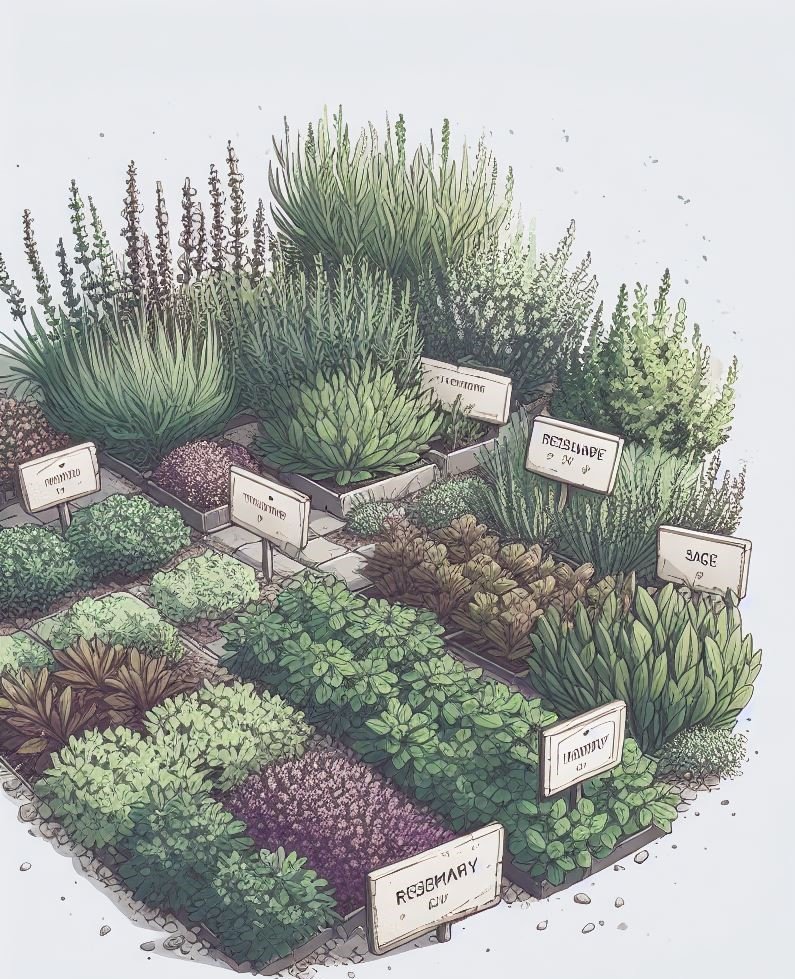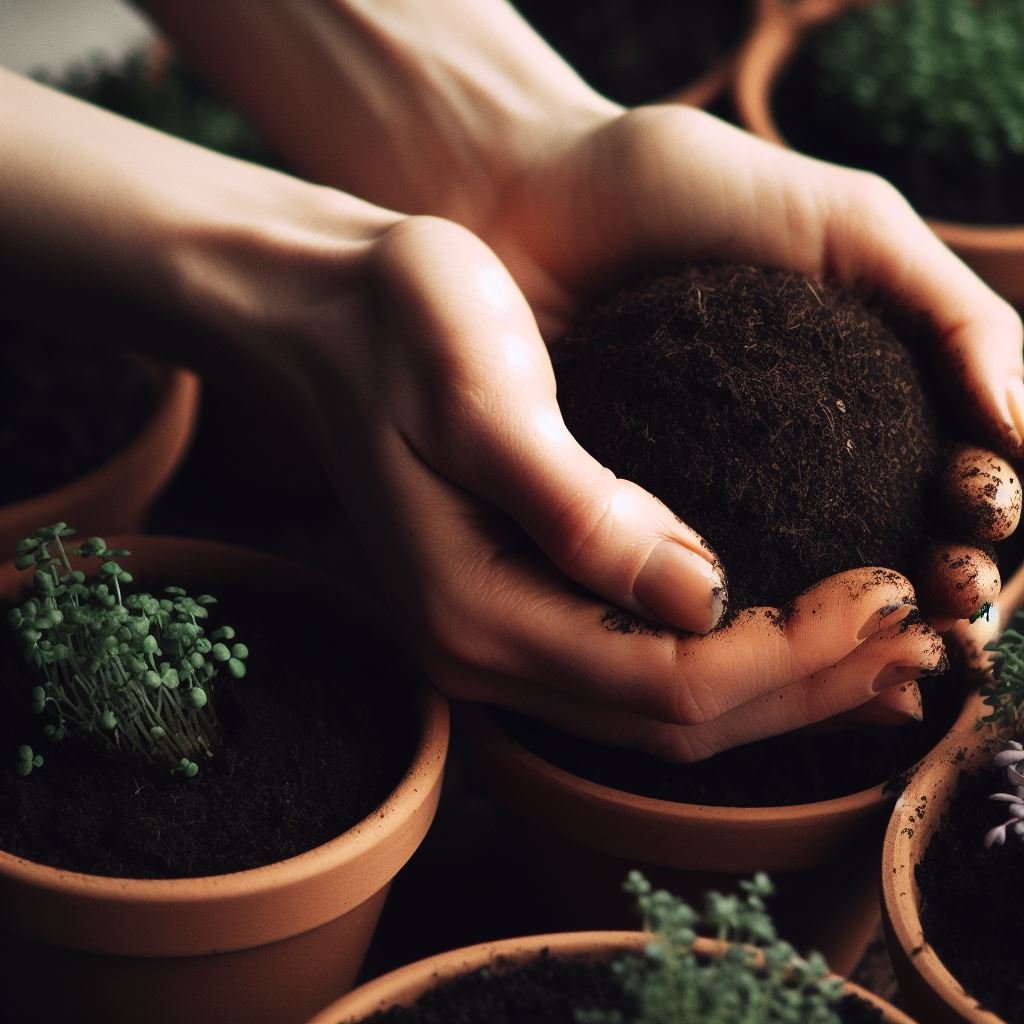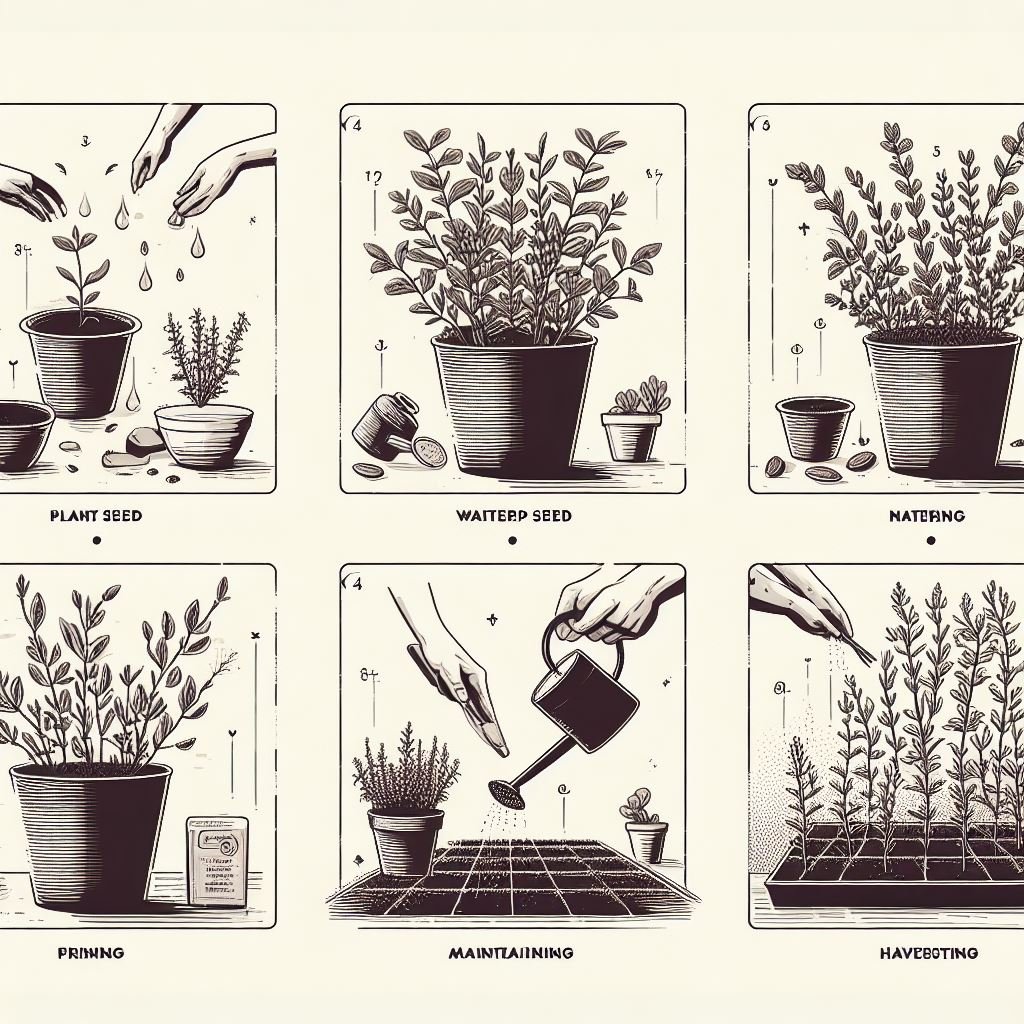As a gardening enthusiast, you must be aware of the benefits and joys that come with nurturing your green refuge. But do you know that herb gardens are not only aesthetically pleasing but also low maintenance, making them an ideal choice for both beginners and professional gardeners?
Welcome to our blog, where we delve into the art of mastering low-maintenance herb gardens, so you can reap the benefits of homegrown herbs without having to compromise on your busy schedule. We will guide you through the entire process, from choosing the right herbs to efficient ways of maintaining them.
Prepare to unlock a world of aromatic beauty and culinary delight right in your backyard! So, stay with us as we unfold the secrets to a thriving herb garden that requires minimal upkeep.
Understanding Herb Gardening
| Aspect | Description |
|---|---|
| Low Effort | Minimal time and energy required. |
| Smart Tools | Use of technology for automation. |
| Low Maintenance | Minimal time and energy are required. |
| Sustainable | Environmentally friendly practices. |
.Herb gardening can be a delightful venture, offering not only a sensory feast with its enticing aromas and textures but also the satisfaction of adding homegrown freshness to your meals. Yet, the prospect of starting an herb garden might seem daunting to beginners, especially those who are concerned about the time and effort required. This is where low-maintenance herb gardening tips come into play.
The beauty of an herb garden lies in its simplicity. Many herbs are hardy, resilient, and surprisingly easy to grow, making them a perfect choice for novice gardeners or those with busy schedules. With the right planning and a few smart strategies, you can cultivate a flourishing herb garden that asks for little yet gives abundantly.
The first step towards a low-maintenance herb garden is choosing the right plants. Herbs like rosemary, thyme, and mint are known for their robust nature and can thrive with minimal attention. Planting these in well-drained soil, ideally in a spot with plenty of sunlight, sets the stage for a garden that largely takes care of itself.
Watering is another aspect to consider. While herbs do need moisture, overwatering can lead to root rot. A good rule of thumb is to let the top inch of soil dry out between waterings.
This not only saves you time but also ensures that your herbs stay healthy and vibrant. Lastly, don’t forget about harvesting. Regularly picking your herbs not only provides you with fresh ingredients for your meals but also encourages new growth, keeping your plants lush and productive.
In conclusion, an herb garden doesn’t have to be a time-consuming endeavor. With these low-maintenance herb garden tips, you can enjoy the pleasures of gardening without it feeling like a chore. After all, gardening should be about joy, relaxation, and the simple satisfaction of growing something with your own two hands.

What is Herb Gardening?
Herb gardening is the art and science of cultivating herbs, those versatile plants known for their culinary, medicinal, and aromatic properties. Whether you’re aspiring to a kitchen garden brimming with mint, rosemary, and thyme, or a quiet sanctuary of calming lavender and chamomile, our low-maintenance herb garden tips will guide you. We’ll help you nurture your green thumb, without the requirement of round-the-clock attention.
With careful planning, the right resources, and a pinch of patience, you’ll soon enjoy the gratifying process of nurturing your plants, and the rich rewards of your own homegrown herbs.
Benefits of Herb Gardening
Herb gardening offers numerous benefits, from spicing up your culinary endeavors to enhancing the aesthetics of your home. The delightful fragrance of herbs can transform your living space into a natural haven. Moreover, these green gems are a treasure trove of medicinal values.
But the idea of gardening can be daunting for some, especially those with a busy lifestyle. Worry not! With our low-maintenance herb garden tips, you can easily cultivate your green thumb. These tips will ensure your herb garden thrives with minimal effort, allowing you to enjoy the multifaceted benefits of these botanical wonders without breaking a sweat.
Choosing the Right Herbs
Section Title: Sage Advice: Low-Maintenance Herb Garden Tips for the Budding Herbalist Delving into the world of herb gardening can be an incredibly rewarding experience. Not only do you get to nurture a living thing from seed to harvest, but you also get to enjoy the fruits (or, in this case, leaves) of your labor in your cooking. However, as with any new endeavor, it can be slightly overwhelming to know where to start.
Choosing the right herbs to grow is the first step in creating a low-maintenance herb garden. Certain herbs, like basil, chives, and mint, are particularly forgiving for novice gardeners. They are robust, grow quickly, and aren’t overly fussy about their living conditions.
This means they are less likely to succumb to common gardening plights, such as pests or inconsistent watering. Other herbs, like rosemary and thyme, are perennials, meaning they will continue to grow year after year. This can make them an excellent investment for your garden.
Plus, their hardy nature makes them a great choice for those looking for a low-maintenance option. Of course, choosing the right herbs is only one part of the equation. You’ll also need to consider factors like sunlight, soil quality, and watering needs.
But don’t worry, we’re here to demystify the process and provide you with all the low-maintenance herb garden tips you need to become a green-thumbed guru in no time. As you dive into this vibrant and fragrant world, remember that gardening is a journey, not a destination. It’s about learning, experimenting, and, most importantly, enjoying the process.
So, let’s roll up our sleeves, get our hands a little dirty, and discover the joy of herb gardening.
Best Herbs for Beginners
Starting an herb garden can be a daunting task, especially for beginners. However, with the right low-maintenance herb garden tips, you can turn your thumb green in no time. The key is to start with hardy, easy-to-grow herbs such as basil, mint, rosemary, and chives.
These herbs not only tolerate a range of growing conditions but are also versatile in the kitchen, adding a fresh burst of flavor to your dishes. So, don’t let your lack of gardening experience deter you. Embrace the challenge and cultivate a thriving herb garden that will reward you with fresh, aromatic herbs all year round.

Herbs that Thrive with Minimal Care
Cultivating your herb garden doesn’t require a green thumb, thanks to some hardy herbs that flourish with minimal attention. These low-maintenance herb garden tips will help you grow a verdant paradise filled with flavor-packed plants. From the aromatic rosemary that thrives in neglect to the resilient chives that refuse to be phased by changing seasons, these herbs are the superheroes of the garden world.
So, whether you’re a seasoned gardener or a novice, these tips will help you cultivate a thriving herb garden without the need for constant care and attention.
Climate Impact on Herb Choices
The climate can significantly affect the success of your herb garden. Thus, understanding how different weather conditions influence herb growth is crucial. If you’re looking for low-maintenance herb garden tips, it’s wise to select herbs that are well-suited to your local climate.
This approach not only minimizes the required care but also boosts the chances of a bountiful harvest. Whether you’re dealing with a scorching summer or a frosty winter, there’s always a hardy herb that can thrive in your garden. So, let Mother Nature guide you in creating a thriving, low-maintenance herb garden.
Setting up Your Herb Garden
Setting Up Your Low-Maintenance Herb Garden: The Ultimate Guide Imagine a tranquil garden corner brimming with aromatic herbs, adding a dash of life to your culinary dishes. Sounds idyllic, doesn’t it? Now, what if we told you that maintaining such a garden isn’t as time-consuming or labor-intensive as you might think? This article is here to share some top-notch low-maintenance herb garden tips that will get your green thumb tingling with anticipation! Firstly, choose hardy herbs that can withstand fluctuating weather conditions. Options like rosemary, thyme, sage, and oregano require minimal care yet provide maximum flavor.
Next, consider planting in pots. This not only allows you to control the soil and water conditions better but also makes it easier to bring the herbs indoors during harsh weather conditions. Finally, remember that less is more when it comes to watering.
Overwatering can often cause more damage than under-watering. Embracing these low-maintenance herb garden tips will transform your gardening experience. No longer will you be a slave to your plants’ whims; instead, you’ll master the art of effortless gardening, reaping the rewards of fresh, homegrown herbs with a fraction of the effort.
Now, isn’t that a breath of fresh thyme-scented air?
Choosing the Right Location
Selecting an ideal location is paramount when considering low-maintenance herb garden tips. It’s not merely about convenience; it’s also about ensuring the herbs flourish. The right location balances good sunlight, adequate drainage, and proximity to your kitchen for easy harvesting.
These elements create a self-sustaining ecosystem, reducing the amount of care required. Remember, an ideal location fosters growth and minimizes stress for your herbs, making your gardening experience more enjoyable and less of a chore. Hence, choose wisely and let your herb garden be a testament to your brilliant decision-making skills.
Proper Soil Preparation
Proper soil preparation is essential for a successful herb garden. This blog section provides low-maintenance herb garden tips, emphasizing the importance of correct soil preparation. With proper soil preparation, your herbs will not only thrive but also require less maintenance.
It’s all about establishing a strong foundation from the start. After all, even the hardiest herbs can struggle without the right soil conditions. So, if you want a bounty of basil, a proliferation of parsley, or a raft of rosemary, start with the soil.
It’s not rocket science, but a bit of gardening wisdom that never fails.
Maintaining Your Herb Garden
Maintaining an herb garden can be a rewarding endeavor. However, as with any garden, it requires consistent care and attention. If you’re looking for low-maintenance herb garden tips, you’ve come to the right place.
Firstly, it’s essential to remember that herbs are generally hardy plants that thrive in various conditions. However, they still require necessities like water, sunlight, and good soil. A clever trick is to group herbs with similar needs. For example, drought-tolerant herbs like rosemary, thyme, and oregano can be grouped, while moisture-loving herbs like mint and basil can share a pot.
Another essential tip is to prune your herbs regularly. Pruning not only helps to maintain a plant’s shape but also encourages new growth. So, don’t be afraid to use your herbs in your cooking frequently! Moreover, keep an eye out for pests and diseases.
Even the most robust herb garden can fall prey to unwanted pests. Regular inspection can help you spot any early signs of trouble and treat it promptly. Lastly, while fertilizing is not always necessary for herb gardens, a light feeding in the spring can give your herbs a good start.
In conclusion, maintaining a low-maintenance herb garden doesn’t necessarily mean no maintenance. But with these handy tips, your herb garden can thrive with minimal effort, providing you with a bountiful harvest to add flavor to your meals. Happy gardening!

Watering Techniques for Herbs
Nurturing a verdant herb garden doesn’t have to be arduous. With our low-maintenance herb garden tips, you can ensure your garden thrives with minimal fuss. Understanding the ideal watering techniques is vital.
Overwatering can lead to root rot, while underwatering can dehydrate your herbs. The trick is to strike a balance; watering deeply but less frequently encourages healthy root growth. Make sure the topsoil is dry before watering again, and avoid watering in the evening to prevent overnight dampness.
With these simple yet effective watering techniques, you can cultivate a flourishing herb garden with minimal effort.
Managing Pests and Diseases
Navigating the world of herb gardening can be a daunting task, especially when pests and diseases threaten your green dreams. But don’t let these challenges deter you! With our low-maintenance herb garden tips, you can maintain a thriving oasis without breaking a sweat. From selecting disease-resistant varieties to encouraging beneficial insects, our surefire strategies will help you keep pests and diseases at bay with minimal effort.
So, let’s dive in and unravel the secrets to managing pests and diseases, allowing you to enjoy a lush, healthy herb garden with ease.
Harvesting and Using Your Herbs
Taking care of a herb garden doesn’t have to be a labor-intensive project. With a handful of low-maintenance herb garden tips, you can enjoy a thriving and aromatic green space. One of the key components of maintaining an effortless herb garden involves selecting resilient herbs.
Herbs such as rosemary, thyme, and mint are known for their hardy nature, making them ideal for beginners or those with a busy schedule. Once your herbs have reached their peak, it’s time for harvesting. The best time to harvest herbs is in the morning when their essential oil content is at its highest.
Harvest by snipping off the top leaves and stems, leaving the lower leaves to continue growing. After harvesting, you can use your herbs fresh or dried. Fresh herbs are great for immediate use in cooking, while dried herbs are excellent for long-term storage.
To dry your herbs, tie them in small bundles and hang them upside down in a warm, dry place. Once completely dried, store them in airtight containers out of direct sunlight. Remember, a low-maintenance herb garden doesn’t mean no maintenance at all.
These herbs still require basic care such as regular watering and occasional pruning. But with these tips in hand, you can minimize the effort and maximize the enjoyment of your herb garden. So, go ahead, roll up those sleeves, and get ready to enjoy the fruits, or in this case, herbs, of your labor.
When and How to Harvest
Harvesting your low-maintenance herb garden requires a keen sense of timing and proper technique. Ideally, herbs are best harvested just before their flowering stage, when they have the highest concentration of oils, ensuring maximum flavor and aroma. Gently snip the herbs early in the morning, after the dew has dried but before the sun’s heat can diminish their freshness.
Be sure to leave enough foliage for the plant to continue growing. With these practical tips, your low-maintenance herb garden will provide a bountiful and consistent harvest.
Storing and Using Your Herbs
Maintaining a thriving herb garden doesn’t have to be labor-intensive. With our low-maintenance herb garden tips, you can reap the aromatic benefits without the hassle. Discover smart storage solutions, such as air-drying or freezing, to preserve your bounty.
Uncover the art of efficient watering and suitable sunlight exposure to keep your herbs vibrant. Learn how to combat common pests in a non-toxic way. With these simple and effective tips, your herb garden will flourish with minimal effort, and your kitchen will be brimming with fresh flavors all year round.
Frequently Asked Questions (FAQs)
What are some tips for creating a low-maintenance herb garden?
To create a low-maintenance herb garden, consider using perennial herbs that will come back year after year. Choose herbs that are native to your area as they will be more resistant to pests and diseases. You can also use mulch to reduce weeds and maintain soil moisture, and consider using a drip irrigation system for easy watering.
Which herbs are best for a low-maintenance garden?
Herbs like rosemary, thyme, mint, and oregano are great choices for a low-maintenance herb garden. They are hardy plants that require little care other than regular watering and occasional trimming.
How can I keep my herb garden low-maintenance during the winter?
During winter, protect your herb garden by adding a layer of mulch or compost to insulate the soil. Also, consider moving potted herbs indoors or in a greenhouse to protect them from frost. Remember to water less frequently as herbs need less water in colder months.
What is the best way to water a low-maintenance herb garden?
The best way to water a low-maintenance herb garden is to use a drip irrigation system. This ensures that the herbs get water directly to their roots, which helps them grow strong and healthy. It’s also a good idea to water in the morning to reduce evaporation
Do I need to fertilize my low-maintenance herb garden regularly?
Fertilizing is not necessary for most herbs. However, if you notice your herbs are not growing as well as they should, a slow-release organic fertilizer can be applied in the spring. Always follow the package instructions when using fertilizers.
How can I control pests in my low-maintenance herb garden?
One of the best ways to control pests in a low-maintenance herb garden is to grow companion plants that naturally repel pests. For example, mint can deter ants and aphids, while basil can repel mosquitoes and flies. Regularly check for signs of pests and treat any infestations early.
Conclusion
Maintaining an herb garden doesn’t need to be a daunting task that requires hours of dedication and a green thumb. Simply follow these tips, like choosing the right herbs, utilizing space wisely, taking advantage of natural light, watering appropriately, and keeping pests at bay. Remember, the key to a low-maintenance herb garden is smart planning, not hard labor.
Keep it simple, keep it organic, and most importantly, keep it stress-free. After all, your herb garden should be a source of culinary delight, not a cause of gardening fright. Happy herding!
